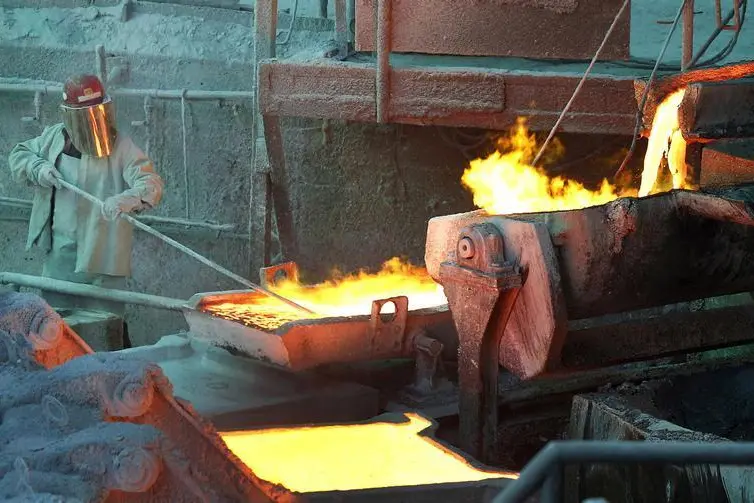PHOTO
LONDON - Funds are turning increasingly bearish on copper as China's manufacturing recovery falls short of expectations and growth slows in the rest of the world.
London Metal Exchange (LME) three-month copper broke the downside of its recent trading range last week, hitting a five-month low of $8,136.50 per tonne on Friday.
Investor positioning on the CME copper contract was already net short before last week's price slide, and funds have also been bailing out of long positions on the London market over the last month.
The macro negativity to copper is currently being reinforced by a weak micro picture, with Chinese imports falling and LME inventories rising.
INVESTORS TURN BEARISH
Money managers on the CME briefly flirted with the short side in March but have turned decidedly more bearish since the start of this month.
Outright short positions have mushroomed by 68% to 58,157 contracts in the space of three weeks. Outright long positions have been scaled back to 41,987 contracts, almost half the level of the February peak when investors were betting on a full-throttle post-COVID recovery in China.
Fund managers are now net short of CME copper to the tune of 16,170 contracts, the largest collective bear bet since August last year.
The latest Commitments of Traders report denotes the positioning landscape at the close of business last Tuesday, before copper tumbled out of its trading range.
Momentum funds are likely to have added to existing short positions in response to the price action, particularly since the LME three-month price broke down through the 200-day moving average, a closely watched technical indicator.
The London market has also seen a mass exodus of fund managers from the long side of copper in the last few weeks.
Investment funds have slashed their net long positioning from 25,737 contracts on April 14 to just 4,813 contracts as of May 5.
The last time investment funds were net short of LME copper was in the first half of 2020, when the metal was reeling from the first wave of COVID-19.
WEAK RECOVERY
China's recovery from the stringent zero-COVID policy of last year has so far fallen short of expectations from a metals perspective.
Growth has been led by the services sector, with the country's huge manufacturing sector struggling to pick up momentum.
Factory output shrank in April, according to both official and private-sector purchasing managers surveys. Manufacturers are struggling with weak demand from both export and domestic markets, particularly a stubbornly sluggish commercial construction sector.
Although there are signs of growing super-cycle demand from green energy transition sectors, it is evidently not yet strong enough to counter the old industrial cycle.
The cloudy macro outlook is mirrored in copper's current bearish micro optics.
China's imports of refined metal have slumped this year. Net inflows fell by 16% year-on-year to 700,000 tonnes in the first quarter, and the preliminary figures for April suggest it was another low-volume month.
This is down both to lower imports, but also to a jump in exports of Chinese refined metal. Outbound shipments totalled 102,000 tones in the first three months of 2023, up 56% on the same period of last year.
Some of that metal has been making its way to LME warehouses. The amount of Chinese copper warranted in exchange warehouses grew from just 925 tonnes at the end of January to 26,675 tonnes at the end of April.
RISING INVENTORY
Deliveries of Chinese metal have helped LME-registered stocks rebuild from a mid-April low of 51,550 tonnes to a current 76,875 tonnes.
The amount of copper awaiting physical load-out from LME warehouses is minimal at just 225 tonnes, suggesting little spot demand for exchange metal.
LME spreads are relaxed, implying more metal may be sitting in the off-market shadows. The benchmark cash-to-three-months period closed Friday valued at a wide $30.00 per tonne contango.
Stocks, however, are still low by historical standards.
Global visible inventory, including all three exchanges, LME shadow stocks and INE bonded stocks in China, grew by 112,000 tonnes to 325,000 tonnes over the first quarter of this year, but were still 56,000 tonnes lower than a year before.
The inventory cushion is thin and could easily disappear if China's imports start accelerating again.
The import-negative arbitrage so far this year has been down as much to low available stocks outside of China as it has to demand weakness in China, according to Graeme Train, head of metals and minerals analysis at Trafigura.
The trade house is confident China will return in force to the import market as its own inventories are drawn down.
Until that happens, however, fund managers will see no reason not to continue playing the market from the short side.
Indeed, they may step up the bear attack if LME copper, last trading at $8,300 per tonne, can't break back up through the 200-day moving average at $8,360 and regain its previous trading range.
The opinions expressed here are those of the author, a columnist for Reuters.
(Editing by Jan Harvey)





















